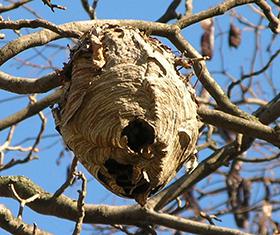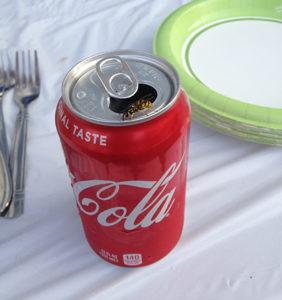The term "hornet" is often used to refer to many of the wasps that build large papery nests. The most notable paper wasp is the baldfaced hornet, Dolichovespula maculata, and several species of yellowjackets (Vespula sp.), which are really wasps. In actuality the only true hornet found in the United States is the European hornet, Vespa crabro L.
Description
Baldfaced hornets may be best described as large, black and white, heavy-bodied wasps about 3⁄4-inch long. They typically build exposed, mottled grey nests in trees or shrubs (Figure 1). Occasionally, the wasps will build nests under roof overhangs, in attics, crawlspaces and wall voids, or under decks or porches. The nests are constructed of a paper-like martial formed from chewed wood. The nests are often described as "football shaped," but they may exceed a basketball in diameter.
Yellowjackets are housefly-sized wasps with distinct yellow and black markings and a few hairs. They construct a similar type of paper nest; however, it will be tan in color, much smaller in size compared to the hornet nest, and is usually found in an underground cavity. Common locations for nests are in lawns, particularly in sandy exposed areas, as well as at the base of trees or shrubs. Occasionally, yellowjackets nest in attics or walls, voids of houses, or storage buildings.
Life History
An individual hornet or yellowjacket queen begins building a nest alone in the spring. Once a queen has produced enough workers to take over nest-building and foraging duties, she remains inside producing more offspring. The workers expand the nest, forage for food, feed the young and defend the nest. Like other predatory wasps, their diet consists mainly of other insects such as flies and bees. Baldfaced hornets also feed on their yellowjacket relatives. They continue to enlarge the nest until fall when there may be 300 to 400 hornets, or 600 to 800 yellowjacket workers. Frequently, it is not until this time that the nest is noticed, although it has been there for many weeks already. In the late summer, the colony produces reproductives, the insects that will mate. The mated female reproductives will serve as the next generation of queens the following spring. The male's main purpose is mating and they cannot sting. Nests are abandoned by wintertime and the future queens seek shelter alone, in protected places under tree bark, in old stumps, or sometimes attics. The current year's nests are not reused the following spring.
Behavior
Yellowjackets, in particular, may be late season pests around picnics, trash cans, and hummingbird feeders as they scavenge. The only way to control this situation is to locate and destroy the nest, which is rarely possible. As an alternative, keep all outdoor food and drinks covered when not actually eating. Drink from cups rather than cans where wasps can crawl inside (Figure 2). "Bee guards" or a coating of petroleum based chest rub can be applied on hummingbird feeders where the insects land. Trash cans should be kept covered or have a flap over the opening. Defensive behavior most often occurs when the insects are defending their nest from "intrusions" (including you walking by a nest or stepping on or near a yellowjacket nest. If the nest is not in the immediate vicinity the likelihood of stings is greatly reduced.
Control
The first decision to make is whether control is actually necessary. Two points to remember:
- In spite of their reputations, hornets and yellowjackets are actually beneficial because they prey on many insects that we consider to be pests. They also serve as food for bears, skunks, birds, and other insects.
- Unlike honey bees, hornet and yellowjacket colonies die out each year.
If a hornet nest is built high in a tree, you may choose to simply wait until the colony dies out in late fall or early winter. The nest will slowly deteriorate from weather or from attack by hungry birds. If a nest is located where people may be stung or if you (or others) are hypersensitive to bee or wasp stings, then colony destruction may be appropriate. Here are some points to consider as you decide how to approach the problem:
- Control is best achieved by applying a pesticide directly into the nest opening. This can be done at anytime of the day, but near dusk, most of the wasps are more likely to be inside the nest. You can use any of the aerosol "Wasp & Hornet" sprays that propel insecticide in a stream about 10-12 feet. Direct the spray into the nest opening and then move away from the area in case any of the wasps emerge from the nest. You may need to repeat the treatment the following evening.
- Long sleeved shirt and long pants may be worn when spraying to make the applicator feel more at ease.
- Do not hold a lit flashlight or stand near car headlights or other lights. Emerging wasps may be attracted in that direction and sting anyone nearby.
- Do not pour gasoline or petroleum down a nest hole. This is extremely hazardous and environmentally unsound.
If the nest is in a wall void or other inaccessible area in your home, you may consider hiring a pest control company to do the work for you. If the nest is in a wall, it may be desireable to remove it if convenient after spraying to avoid attracting carpet beetles that can invade the home and attack garments made of wool, silk, or fur. Yellowjacket traps (commercial or otherwise) have not shown to be of any value in reducing a yellowjacket problem. For more information, see the North Carolina Agricultural Chemicals Manual.
For assistance with a specific problem, contact your local Cooperative Extension center.
Publication date: June 30, 2018
The use of brand names in this publication does not imply endorsement by NC State University or N.C. A&T State University of the products or services named nor discrimination against similar products or services not mentioned.
Recommendations for the use of agricultural chemicals are included in this publication as a convenience to the reader. The use of brand names and any mention or listing of commercial products or services in this publication does not imply endorsement by NC State University or N.C. A&T State University nor discrimination against similar products or services not mentioned. Individuals who use agricultural chemicals are responsible for ensuring that the intended use complies with current regulations and conforms to the product label. Be sure to obtain current information about usage regulations and examine a current product label before applying any chemical. For assistance, contact your local N.C. Cooperative Extension county center.
N.C. Cooperative Extension prohibits discrimination and harassment regardless of age, color, disability, family and marital status, gender identity, national origin, political beliefs, race, religion, sex (including pregnancy), sexual orientation and veteran status.


